9. Do I have a ‘problem’ or a ‘trouble’?: Comparing synonyms with COCA
Fernanda Pederiva and Johanna Tumux
Fernanda Pederiva
Undergraduate student at Federal University of Rio Grande do Sul
Johanna Tumux
Undergraduate student at Montclair State University
Goals: To teach students the difference between the words “problem” and “trouble” by viewing their contexts and grammatical constructions as presented in corpora.
Audience: Intermediate learners of English, ranging from middle school to adult-level classes
Duration: 40-45 minutes
INTRODUCTION
While the words “problem” and “trouble” have similar meanings, they appear in different contexts. Learners of English tend to confuse these two words because dictionary definitions tend to be circular, saying that trouble equals problem and vice-versa. This task aims to use corpus tools to help students differentiate between these two words. We hope that with this task students will learn that these two words are not interchangeable and that they must each follow common grammatical patterns. After integrating a lesson with corpora to present these differences, two activities will be provided at the end to help students solidify their understanding of the topic.
STEP 1: CORPUS ANALYSIS
We will first explore the frequency and contexts of each word using COCA and the BNC. In COCA, we can use the List option in the Search tab, and search for both words separately. Each result should automatically lead you to the frequency counts of the word, as shown in the figures below.
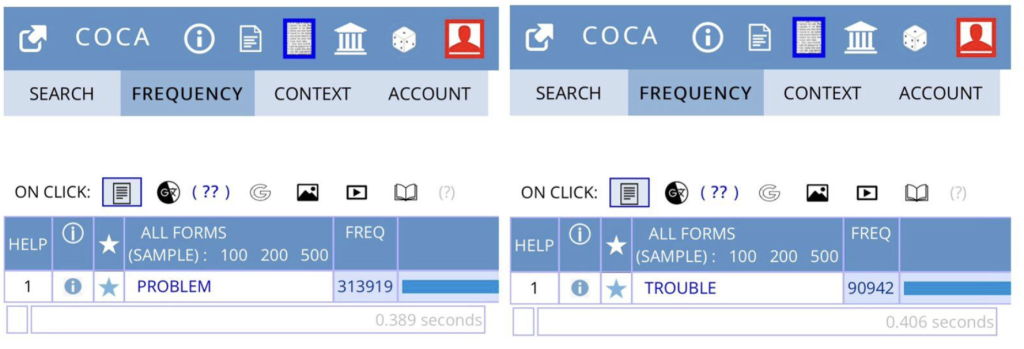
Figure 1 – COCA Frequency results for “problem” and “trouble”
As we can see, the word “problem” can be found more than three hundred thousand times in the corpus. In comparison, “trouble” can be found only ninety one thousand times. At this stage, teachers should point out that “problem” is way more frequent than “trouble”. After highlighting the differences in frequency, then the teacher should talk about how the use of this word varies across different registers, using the Chart options. The chart option shows that “problem” is more frequent in spoken conversations and blogs, while the word “trouble” is more frequent in TV/Movies and fiction.
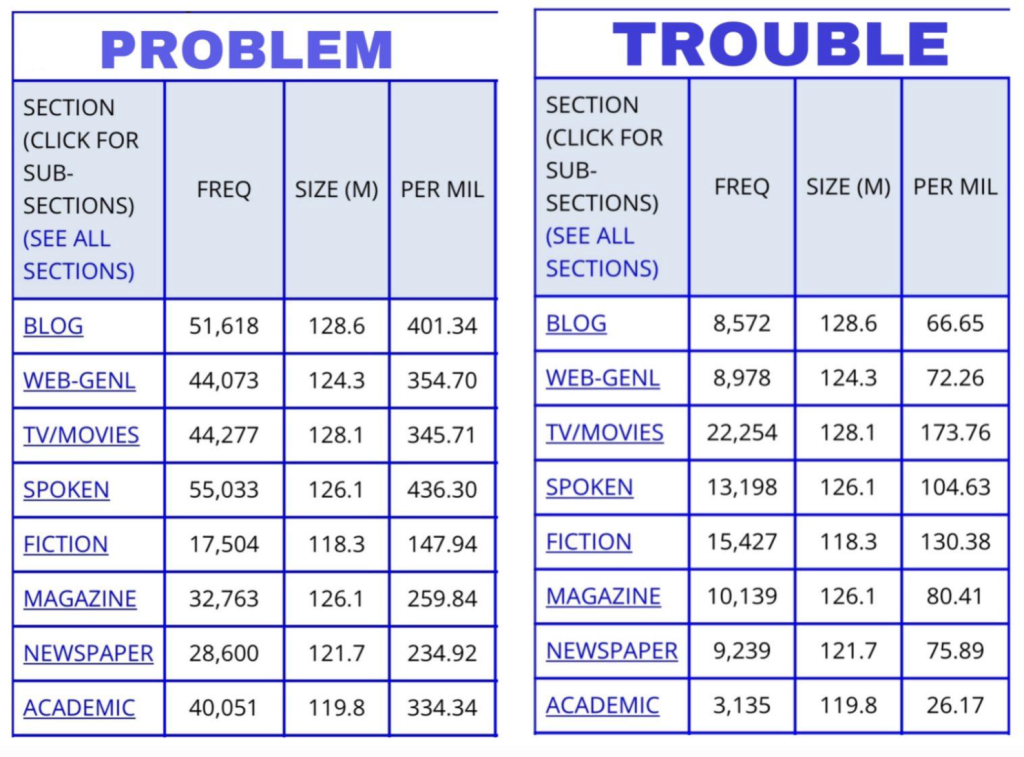
Figure 2 – Chart search results for “problem” and “trouble”
While these observations do present differences between the two words, it is still unclear how the context of use of each word differs. One way to understand the difference between these two words is to look at their collocates.
In order to look at the collocates of “trouble” and “problem”, we will use the British National Corpus (BNC). Using the English-Corpora interface, we can examine the collocates for both words. This is an extremely helpful tool, as it demonstrates how the word is used and what it means in various instances throughout the corpus.
Using the collocates tool on the BNC, we find the following collocates for “problem” and “trouble”.
Problem
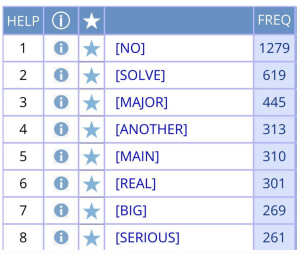
Figure 3 – BNC collocate search results for “problem”
The collocate search results for “problem” show that the word frequently comes after adjectives such as “major”, “main”, “real”, “big”, and “serious”. At this point, the teacher should discuss with the students what the collocates tell us about the meaning of this word. One suggestion is to highlight that “problem” means something is really wrong and/or needs to be resolved. This is why the verb “solve” also collocates with this word.
Trouble
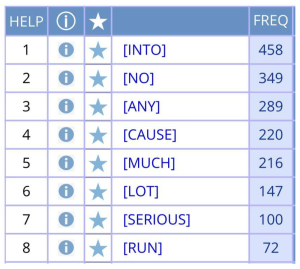
Figure 4 – BNC collocate search results for “trouble”
The word “trouble” comes after verbs like “cause” or in sentences with a verb preposition pattern (for example, “get into trouble”). The teacher should again highlight that based on the collocates, we can see that this word is used to mean a state that one can get into, specifically when a bad thing happens.
The BNC has another function, Compare, that compares two words by showing the frequency in which their collocates appear in comparison to one another. The Compare results for “problem” and “trouble” further solidify the collocate differences between the two words and hence their contextual meanings as stated in the collocate discussion.
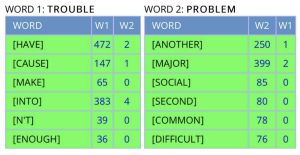
Figure 5 – BNC compare search results for “trouble” and “problem”
STEP 2: PRACTICE ACTIVITIES
These activities should be done after the teacher finishes Phase I of class with the students.
Activity 1
Complete the sentences below, extracted from COCA, with either “trouble” or “problem”
- I can’t believe they solved that math ___________________ in two seconds flat.
- yeah we heard you’re having some ________________ with your roof.
- Maybe she has a drinking and a memory ___________________.
- People who eat these products can get into serious ______________________.
- If the Congress neglects to address this security ____________________.
- Well, Ava has __________________ sleeping.
Activity 2
The following activity can be conducted via the following link to a Wordwall, which is a website that lets users create their own fill-in-the-blank quizzes for easy sharing. The following Wordwall consists of phrases from the corpora using either “problem” or “trouble”. For each incomplete sentence provided, students will need to decide whether “problem” or “trouble” fits best according to the sentence’s grammar and context. This exercise can also be printed out as a worksheet.
https://wordwall.net/resource/31614164
Fill in the blanks of each sentence with either “trouble” or “problem”.
- None of this is her fault. I don’t want her to get in ____ for what I did.
- I just had a little ____ putting on my shoes.
- Have them talk it out. Hug at the end. ____ solved with just a little open communication.
- He says he’s been having ____ sleeping. Nightmares, that sort of thing.
- He has labeled illegal immigration ‘a major____’ and pledged to build a border wall.
- How can we reverse this? It’s a social ____.
- As long as I didn’t cause ____, life was good.
- He told her he had an anger ____ and didn’t know how to control his temper.
Activity 3
This second activity is another Wordwall activity. The exercise consists of specific characteristics of the words “problem” and “trouble”. Students will need to match these characteristics to either word as they see fit. This exercise can also be printed out as a worksheet.
https://wordwall.net/resource/31615676
Sort the following characteristics by their respective words.
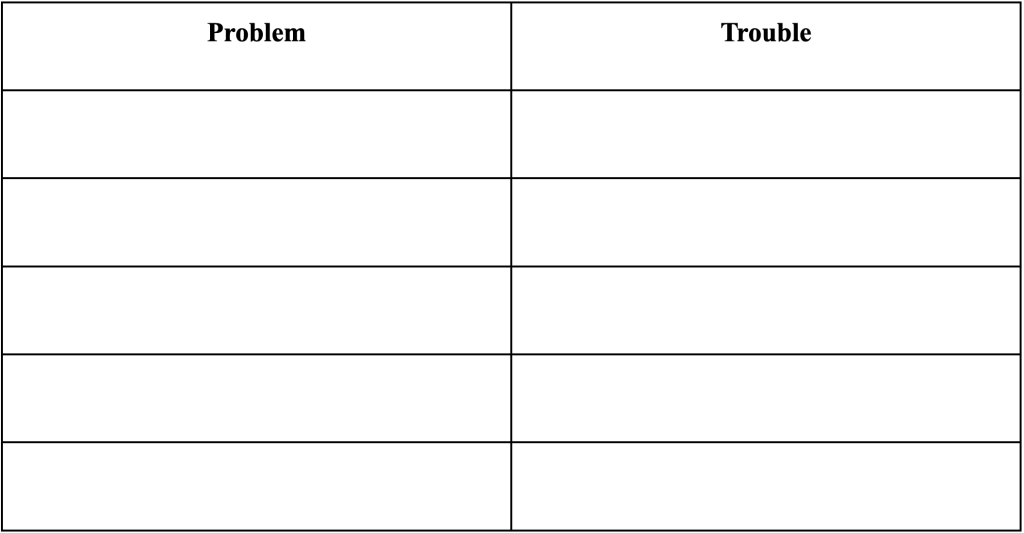
Characteristics:
- Connected to a solution
- Countable
- Used to mean something is wrong
- More frequent in English
- Less frequent in English
- Frequently comes after adjectives
- Uncountable
- Used to mean someone did something wrong
- Usually used with words or prepositions
- Something you can get into
Pederiva, F. & Tumux, J. (2023). Do I have a ‘problem’ or a ‘trouble’?: Comparing synonyms with COCA. In L. Goulart & I. Veloso (Eds). Corpora in English Language Teaching: Classroom Activities for Teachers New to Corpus Linguistics. Open Educational Resource. Montclair State University.
